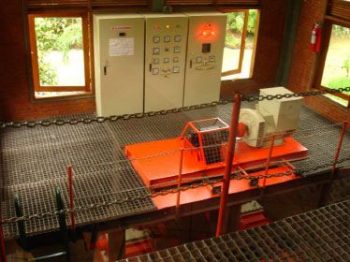A Case Study 1
Background
The Cinta Mekar project is a 120-kiloWatt micro-hydro power plant (MHPP) designed to generate a supply of grid-connected electricity. The project is located in Cinta Mekar village, Subang, West Java, which is about 150 km from the capital city of Jakarta. Cinta Mekar, which consists of four sub-villages, is home to 646 families.
Prior to the start of the project, 102 households were without electricity. Based on the survey carried out by UNESCAP, most villagers are poor rice farmers expecting to benefit from being connected to the main power supply. After over two years of preparations, the plant was completed and launched on April 17, 2004.
Technical Specification of Cinta Mekar’s MHPP
The project utilizes a run-off water from the Ciasem River, with water flow of approximately 1,500 liter/minute. The technical details and an illustration can be seen in Table 1 and Figure 1, respectively. Figure 2 shows the twin turbine used.
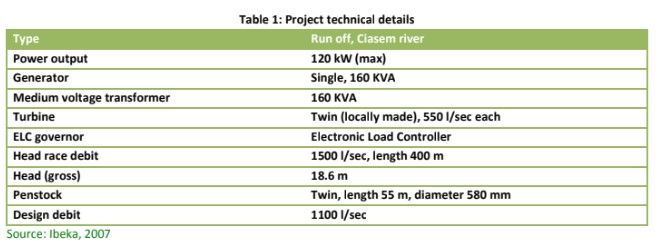
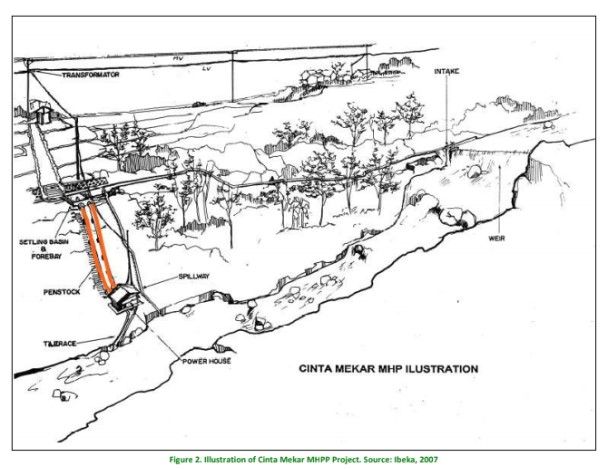
Financing the project
The project is referred to as public-private partnership (PPP) because it is funded and managed by public and private institutions. According to Ibeka, the total project cost of USD $225,000 was borne equally by three parties: a multilateral donor agency, UNESCAP; a private company, HIBS, and a non-governmental organization called Yayasan Ibeka. Both UNESCAP and HIBS contributed $75,000 each to cover the investment cost of the power plant, while Ibeka contributed $75,000 for micro-hydro dissemination, social preparation, and a training facility provided for the village community. Ibeka’s funds came from other donors and in this project HIBS provides technical assistance and the contractor to build the facilities for the MHPP.
While the initial cost of investment was covered by those institutions, the plant is equally owned in a joint venture between the local community and a private company. The community is represented by the Mekar Sari Cooperative (which is comprised of local villagers), and the private company is PT HIBS. Each party claims 50 percent ownership.
The joint venture sells the electricity generated by the plant to PLN, the state-owned electricity company, under a Power Purchase Agreement (PPA) for low voltage and medium voltage connection. The electricity is sold with a tariff of Rp. 432 (or $0.045) per kWh. During operation, monthly sales revenue from the plant is approximately Rp. 25 million1. After depreciation and maintenance costs, the total net monthly profit is approximately Rp. 10 million (roughly $1000), which is shared equally by the Mekarsari coop and HIBS.
According to the agreement prepared in the early stage of the Cinta Mekar MHPP project, Mekar Sari’s share ofthe profits are to be returned to the community with special priority given to the poor. The Mekar Sari Coop has returned the profit to the Cinta Mekar village in the following ways: providing electricity connection; paying fees for education and schooling for the poorest households, building a health clinic, providing seed capital for income-generating activities, village infrastructure development, and other activities.
Stakeholders
The project was initiated by Yayasan Ibeka. This local NGO focuses on rural community empowerment through application of environmentally-friendly technologies. Ibeka initiated the MHPP project development and linked all stakeholders. Ibeka also conducted capacity building activities for the village and the Mekar Sari Cooperative so that the community could be a main player in the project.
The community was represented by the Mekar Sari Cooperative. The cooperative was assigned the responsibility to develop and operate the power plant together with PT HIBS.
The project was elected by the UNESCAP to be part of its 5P program (Pro-Poor Public-Private Partnership) and a grant of $75,000 was awarded. The project also endorsed by the government of the Netherlands and the government of Indonesia through the Ministry of Small Enterprises and Cooperatives and the Ministry of Energy and Mineral Resources.
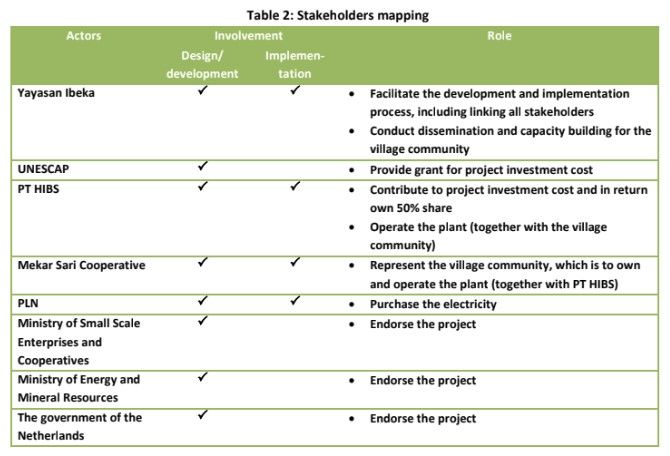
Current situation
The project is currently running as planned, producing and selling electricity to the grid. The partnership between the Mekar Sari Coop and PT HIBS continues to function smoothly. All electricity generated by the plant is sold to PLN.
All profit earned by the Mekar Sari Cooperative is being distributed among the community, as planed. However, there have been some changes to the top priorities among villagers (see table 3). By 2008, the coop paid the connection installation fee for 122 poor households, all of which now receive electricity. Scholarships have been granted to 156 children from the poorest families in the village. A health clinic has been built, and a community radio station and a village telephone have been installed which will improve communication and information access.
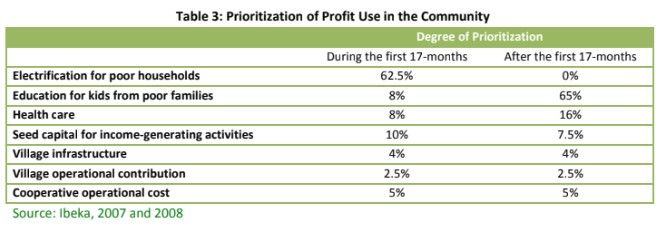
Early in the development stage, villagers were concerned that the project might negatively affect the water supply. They cited fears that there would be less water for irrigation and also that the river water might become polluted (DGEEU, 2009). However, their concerns quickly subsided once the project was implemented and no such problems took place.
A direct result of the MHPP project has been a far more stable supply of electricity for the village. The community has been able to generate revenue and reinvest it in village development through the provision of health care, education, seed-capital and information access.
Energy development throughout all of Indonesia can benefit from this project. The Cinta Mekar MHPP is an excellent example of a community-based, small-scale project that can be successfully implemented with local and affordable technology. The electricity output not only benefits the locals, but rather can contribute to electricity supply for a broader area depending on grid availability.
This project also promotes renewable energy development and has positive environmental impacts, including reduction of fossil fuel dependency and no generation of GHG emissions and local air pollution. Villagers are motivated to protect the forest along the river because it directly influences the rate of water flow.
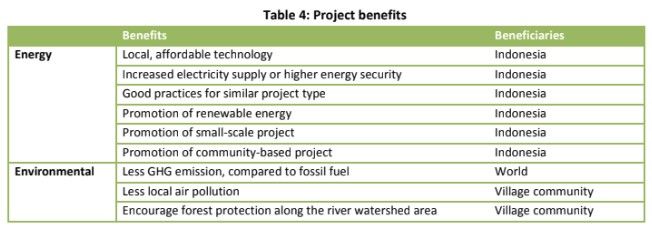

Analysis
The project is considered successful by many parties and is known as the first community-based MHPP that connects and sells electricity to the grid, as well as the first PPP project. The project continues today, thus sustainable benefits are still being delivered to stakeholders.
The project was aimed not only at providing electricity to the village community and the surrounding area, but also at generating income for the village community through the selling of power to the grid. The project is successful due to the community’s capacity for self-management. A great benefit of this project is that the community is able to use the generated income to empower themselves through investment or production activities instead of mere infrastructure development. The community has used the money to build a health care clinic, provide scholarships, supply villagers with electrical access, and offer seed capital for income-generating activities.
A key success factor for this project was an emphasis on community involvement in the planning, development, and implementation stages. While similar projects often view the community solely as the beneficiary, Cinta Mekar involved the community as a main player and owner, allowing the villagers to develop and manage the project. As an owner of the project, the community is integral in the decision making process. Capacity building programs are crucial during the preparation stage in order to bolster organizational skills among community members. Ibeka’s social development team worked closely with the community to prepare them for the roles they would undertake. Preparations involved a preliminary study, setting up the cooperative institution that would represent the community, capacity building, and an ownership assessment. Setting up the institution and operations mechanisms were crucial to ensure that the agreement would be honored.
Once the necessary institution has been formed and all the stakeholders understand their roles, technical preparations can commence. The technology must be well designed and maintained during implementation. The Cinta Mekar MHPP utilized local resources and affordable technology. If this case study is replicated in other remote areas of Indonesia, it would be wise to exploit local resources and use affordable technology.
The success of this MHPP proves that a public-private partnership is a feasible and workable option for renewable energy projects. The determinant factors in this project’s success were: (1) available public funding for the community (2) equal ownership of the venture between the two parties. The Mekar community is relatively poor and lacked the capacity and resources to generate half of the investment cost for the joint venture. Therefore, public funding was necessary to provide capital for the community. Funding support came from the donor agency UNESCAP, which allowed the community to take a position of equal ownership. Both parties to the joint venture had equal power in decision making, thus striking a balance between the motives of both parties.
In the Cinta Mekar case, ownership does matter. Because they own half the project, the local community is motivated to operate the plant as well as maintain the surrounding infrastructure and ecosystem. Specifically, the water stream is of great importance to this project, so the community is invested in protecting the adjacent forest and water source to ensure the sustainability of the project. An additional motivator is the projected revenue stream that will continue to flow to the community as long as the plant operates.
Conclusion
Cinta Mekar MHPP is a successful project from various perspectives: (a) electricity generation come from clean and renewable resources (hydro power), (b) connected to the electricity grid but at the same time able to provide connection for the poor household through subsidized scheme, (c) project implementation is based on the equal partnership of NGOs, the local community and a private investor, with support from multilateral institutions and government endorsement; (d) sustainability of electricity generation and continual revenue stream from the power purchase agreement contract with the utility company; (e) the project contributes to gradual poverty reduction. The impacts of this project will be seen in the long term, but public investment in basic social infrastructure such as health and education will immediately begin to build the foundation for a better community in the future.
Favorable government regulations have benefited the Cinta Mekar project. Regulations enacted prior to the project allow small-scale power producers to sell electricity to the state-owned power utility (PLN). The utility is willing to purchase the electricity from the MHPP at a rate determined by the government. The utility benefits from this arrangement as well, because the purchase price is lower than the cost of electricity generation at a lower or medium voltage distribution. These regulations have created opportunities for small-scale renewable energy projects to come online and connected to the grid.
The initial investment of $2,500-$3,000 per kW is high for a poor community that lacks the capacity and
resources to finance the project on its own. The community was able to establish equal participation
with financial support from external sources. Without this support, community participation would be much
less.
Cinta Mekar’s model and arrangement can be replicated if several conditions are met: (1) external financial support is available, (2) participation of local community is created through awareness raising and capacity building activities, (3) willingness of local community to participate in the project sustains beyond the completion of the project itself; (4) policy and regulatory supports are in place, and (5) the utility is willing to purchase electricity from the plant at a reasonable and fair price that benefits both the utility and the community, thus creating financial incentives for both parties involved.
This case studyreport was prepared by Fabby Tumiwa, Henriette Imelda Rambitan and Olivia Tanujaya of the Instite for
Essential Services Reform (IESR). www.iesr-indonesia.org
References
Ibeka, 2007, Community Private Partnership Pro-Poor Infrastructure: Cinta Mekar Microhydro
Training Power Plant, a presentation by Ibeka in the Seminar on Policy Options for the Expansion of Community-Driven Energy Service Provision held by the UNESCAP in Beijing on March 11-12, 2007. Accesible at http://www.unescap.org/esd/energy/dialogue/community/documents/Presentation%20of%20Cinta%20Mekar.pdf
Ibeka, 2008, Community Private Partnership Pro-Poor Infrastructure: Cinta Mekar Microhydro Training Power Plant, a presentation by Tri Mumpuni (Ibeka) in the Discussion “Sharing Experience of Financing Mechanisms for Low Carbon Projects in Indonesia” held by the National Council for Climate Change in Jakarta on September 9, 2008.
WWF, 2009, Cinta Mekar MicroHydro Plant Adopts Community-Based Microhydro Management. Accessible at http://www.wwf.or.id/berita_fakta/berita_fakta/?9160/Cinta-Mekar-Adopts-Community-Based-Microhydro-Power-Plant-Management-System
DGEEU, 2009, Bring Village to Live with Self-Management Power Plant. Accessible at http://www.djlpe.esdm.go.id/modules/news/mbl_detail.php?news_id=1550
1) Monthly sales revenue is calculated assuming an average
production of 100 kW x 24 hours x 25 days x Rp. 432
A Case Study 2
Improved Cooking Stoves in Kulon Progo: A Modest Way to a Better Life
Introduction
Though there are many stoves available in modern Indonesia, a wood fueled stove remains the most common in Indonesian households. These stoves, formerly called traditional stoves, affect community members’ health and productivity. Such stoves require larger amounts of wood, which results in a longer cooking time. Additionally, these stoves create large amount of ashes. Finding the wood and transporting it home for use requires a substantial amount of time. The experience of a local non- governmental organization, Yayasan Dian Desa (YDD), with communities in Kulon Progo, a district in Yogyakarta, demonstrates the benefits of Improved cooking stove technology. The community in Kulon Progo expressed overall satisfaction with the new technology. One major challenge to advance this technology is that no policies are in place that support its adoption at the community level. Nevertheless, this has not stopped the activity to be well- implemented in several areas in Indonesia.
Project Description
Location
Kulon Progo district in Yogyakarta is known for its coconut sugar production. Most of the villagers work as coconut farmers. Some farmers own their own plantations while others are far wage workers. Coconut sugar is one of the main produce. A local non-governmental organization, Yayasan Dian Desa (YDD or Dian desa) works with the villagers Dian Desa works with two sub-villages in Hargo Rejo, a major cluster of the Kulon Progo district. The first sub-village is Dusun Gunung Rego and the other is Dusun Gunung Kukusan. In 2007, the population of Hargo Rejo was 10,870 and the village consists of 16 sub-villages, including two sub-villages where the project was implemented (Kulon Progo dalam Angka, 2007).
Both sub-villages are located in a mountainous- limestone area, which means that in dry season, water becomes scarce for people living in this area. Therefore, during the dry season, villagers spend a great deal of time looking for fresh water for their daily use and for farming. Water shortage becomes a challenge for installing other technology such as a bio-digester for biogas production. An improved cooking stove is the most suitable option in water-deficient areas. Improved cooking stoves provide additional benefit for the villagers, including reducing the time it takes to collect wood and to cook.
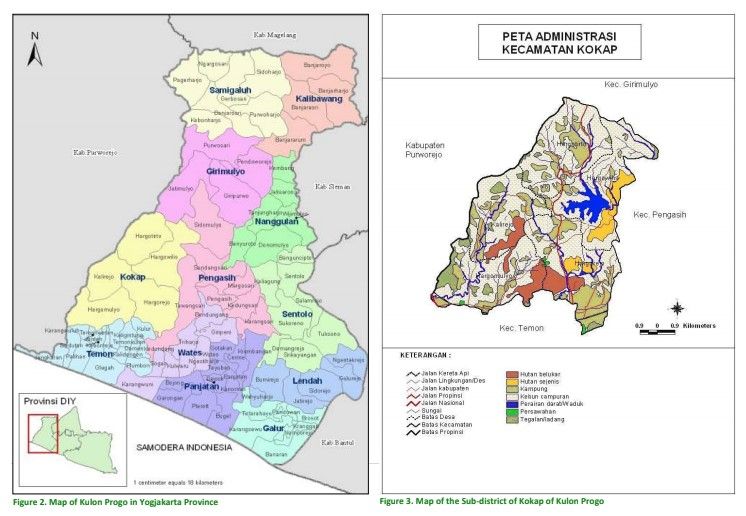
Improved Cooking Stoves as a Practical Alternative
In order to harvest coconut sugar, the villagers make use of nira (2), which must be heated for approximately four hours, on a three-hole-stove fueled by fire wood. However, this method for harvesting coconut sugar is unsafe as it produces high levels of indoor air pollution. Women and children suffer from accute respiration infection due to the excess smoke produced by the fire wood, as women spend most of their time in the kitchen and generally keep their children with by their side as they work.
To mitigate the problems associated with coconut sugar production, the Improved Cook Stove (ICS) technology was introduced in Kulon Progo by Yayasan Dian Desa, a Yogyakarta based NGO that provides villages with biomass technology. The group has been working in the Kulon Progo area since late 1990s. The ICS project aimed to introduce improved cooking stove technology to help local farmer and coconut sugar makers reduce the average cooking time for the coconut sugar, and use less fire wood. Overall its objective is to improve productivity and reduce the cost of producingcoconut sugar.
The ICS was a modification of the existing stove (the three-holes-stoves), which is both healthier and more efficient, in that it eliminates the excessive smoke in the kitchen and reduces the amount of wood needed as fuel. The ICS was introduced in several sub-villages in Kulon Progo.
The improved cooking stoves serve the same purpose as the traditional cooking stove. Thus, villagers have been quite receptive to the new technology. The primary difference between ICS and the traditional cooking stove is structural: the ICS has a chimney and has improved heat distribution inside the stove. The chimney redirect the smoke out of the home and also improve the heat distribution. The villagers reported that by using the improved cooking stoves, they have experienced a significant smoke reduction in their kitchens and the amount of wood required to harvest coconut sugar has been reduced by 50 percent. The communities also noted that ICS has shortened ing times. Additionally, less time is spent collecting wood. With more spare time, women are able to engage in more productive activities, which leads to a higher income.
The ICS has greatly improved the quality of coconut sugar, as it does not leave ashes in the coconut sugar. This is a result of the chimney, which directs the smoke and also particulate matter to the atmosphere and avoids contaminate the sugar dough. Other benefits of the ICS is better health quality of the family (particularly among women who primarily work in the kitchen dealing with the stove), reduced expenses (as wood necessary to fuel the oven has been reduced), better quality of the product as the coconut sugar free from ashes, and shortened cooking time.
Dian Desa as the Local NGO
Dian Desa is an Indonesian NGO that has worked to improve cooking stoves technology since the 1980s. As the focal point for Jaringan Kerja Tungku Indonesia (JKTI– Indonesia’s Stoves Network), Dian Desa has collaborated with a number of local NGOs in Indonesia who work on the same issues. Aside from cooking stove technology, Dian Desa also assisted with capacity building for local NGOs in both technology and project
management.
Moreover, Dian Desa conducted trainings in the area to provide the community members with the tools and training to build their own stoves. Dian Desa helped to form community groups and provided technical support for the groups. The trainings empower the villagers to build improved stoves for themselves and for sale to other sub-villages. Selling stoves to other sub-villages provides community members with an additional source of income. The additional income then can be used for purchasing raw material for building the stoves.
Engaging the Community
A major success of the ICS program is that communities now have ownership over the construction and implementation of the project. Local NGOs have trained villagers in trouble shooting, handling new demands of stoves, and implementing the ICS production and sales. diam Desa’s role in this project should be instructive for future development projects aimed at reducing poverty and empowering local communities. There are several important lessons from this project. First, providing stoves for free (?) did not ensure the sustainability of the project. Instead, it is important to charge villagers a small fee for the service so that they invest time in understanding the project’s value. Each community member pitched in to provide the capital needed to build the first set of stoves. They shared the financial burden of purchasing raw materials. Villagers purchased the raw materials in bulk so that they could build several stoves at the same time. Excess raw materials were used to build more stoves that were then sold to other sub-villages.
It is clear that the villagers handled the finances and onstruction of the ICS more responsibly because they had invested their own money in the project and thus had a vested interest in its success. In order to determine the stove’s price, the villagers were encouraged to decide among themselves about the costing system. This process helped the villagers to determine the affordability of the price for the villagers.
Instilling Village Ownership
Before Dian Desa began helping the villagers to construct the Improved Cooking Stoves, Dian Desa conducted community meetings to engage the community and solicit community input. In the community meetings, the villagers were asked to discuss their current stove and how it could be best improved. The community meeting ultimately gave villagers the opportunity for Dian Desa to gain a deeper understanding of the villagers and their day-to-day lives. Dian Desa also tries to foster a sense of ownership among the villagers in order to ensure the project’s sustainability.
In the meeting, Dian Desa identified the need of villagers to be organized in order to have a structure to manage the project. The village organization serves to ensure that ICS activities run smoothly. The institution is comprised of a leader, vice leader and members. The group would then develop their own meeting schedule and would decide when to partake in trainings from Dian Desa. Dian Desa would continue to provide assistance villagers in the implementation. The local government should also support the Improved Cooking Stoves project, as the project benefits the entire village, financially and in terms of quality of life.
Some practical issues with scaling up improved cooking stove technology There are many people in Indonesia without adequate access to energy. Fire wood, in some areas, is the only energy source available, and it remains inexpensive and is produced elsewehere. Promoting ICS is met with several challenges and opportunities: In Yogyakarta, there is no specific policy that promotes cooking stove activities. At the national level, there was an initiative by the Directorate General of Electricity and Energy Utilization (DJLPE) a few years ago to put the cooking stove program on the national agenda, Due to the financial crisis in 2007, however, the program never came to fruition.
Using cooking stoves also presents some health and gender issues. Indoor air pollution is common for villagers who use traditional cooking stoves and women often suffer from illness as a result of constant exposure to the traditional cooking stoves. The use of improved cooking stoves, however, can reduce health problems.
Opportunities and Challenges
Replicability
Based on Kulon Progo’s experience, the use of improved cooking stoves can be expanded to communities throughout Indonesia, particularly in areas that are dependent on fire wood for cooking and having difficulty accessing kerosene Expanding its use, however, entails the following:
One, Dian Desa has learned that gaining trust from the villagers can be difficult. Without community trust and support the program is bound to fail. Therefore gaining community trust is an important first step to ensure public support for the new technology.
Two, gaining trust involves the support of the NGO’s on the ground as well as support for the new technology. Villagers often find using the new technology to be difficult and frustrating. so the NGO’s must be patient in teaching the villagers to use the new technology. In order to promote the success of the Dian Desa project elsewhere, Dian Desa suggests that the villagers purchase the cooking stove instead of getting it for free from the organization. According to Dian Desa, by purchasing the technology, the villagers gain a sense of ownership over the project and are thus more oriented towards project’s success. If villagers supply seed money for the project, they will feel responsible for the performance and the outcome.
Sustainability
In starting the activities, Dian Desa has stated that the ICS activities at the community level shoulfd be sustianable. Sustainability rests largely on the villagers’ hands. What does this exactly entail?
One, Dian Desa encouraged the villagers to organize themselves into a group or cooperative. Once the groups were established, Dian Desa began to introduce the new technology into the community. Dian Desa provided training on building improved cooking stoves. The local community is responsible for providing the raw materials for the cooking stove, and later they determine the price.
Two, after completing their training and successfully builing the new cooking stoves, villagers install the stove in the buyer’s home and then train the buyer to use it. The villagers thus have the knowledge to build and install the improved cooking stove, become prepared to create a small business, and are able to provide the neighboring villages with new and improved cooking stove technology.
Financing
Each community that Dian Desa had worked with provided nearly 100 percent of the funding. According
to Dian Desa, by making villagers fund their own activities, villagers became more invested in the
building and implementation process. This increased sense of responsibility would encourage the villagers to
operate and maintain the stoves more conscientiously. This project demonstrates that grant money is not
always the most effective financing mechanism. In this case, soft loans would better to meet the objective of
the project, as well as ensure sustainability of the project.
Conclusion
Improved cooking stove (ICS) is a simple technology. However the successful of dissemination of this technology from the case studies in two locations in Kulon Progo was determined by several factors:
1. Acceptance by local community or beneficiaries of the new (or improved) technology and willingness to participate in the whole cycle of the program, including participation in decision making process. Beneficiary ownership of the program is important to ensure the sustainability of the project. In this project, participation of the local community includes providing financing for some of the project’s activities.
2. The technology must be directly related to the needs of the community, and potentially create economic opportunities for the local community.
3. Technology transfer to the beneficiaries is important to ensure the local community has the know-how and the capacity to replicate the technology on a larger scale and and thus reduce the cost of development.
4. Community members must provide financial support for the project. Having technology for free undermines project sustainability. Local people must make an effort to benefit from a new technology and at the same time, technology must be provided at affordable cost or affordable price.
This case study report was prepared by Henriette Imelda Rambitan and Fabby Tumiwa of the Instite for
Essential Services Reform (IESR). www.iesr-indonesia.org.
(2) Nira is the liquid sapped from the coconut’s young
flowers (less than a month old)

